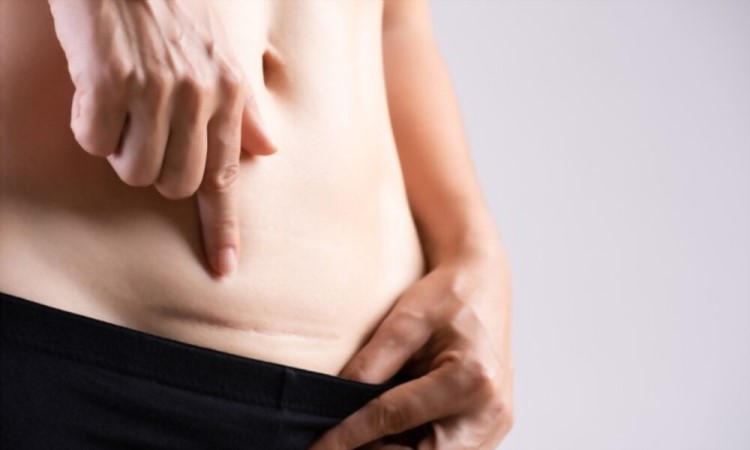Women are instructed to take extra care to avoid getting their incisions wet during the post-op recovery period following a cesarean section. However, many new mothers wonder how to protect their C-section incisions from getting wet. Especially during the sweaty summer days, they wonder how to keep C-section incision dry from sweat. The most effective way to prevent moisture from accumulating around a scar is to expose it to the air. However, this is not practical when it comes to a C-section wound. During the healing process, the wound from a cesarean section cannot be exposed to air throughout the day. Read on to learn how to keep the C-section incision dry and sweat-free.
Why Is It Important To Keep The C-section Incision Dry?
After a cesarean section, the incision in the mother’s abdomen is closed using sutures to reattach multiple layers of muscle and connective tissue. A horizontal or vertical incision is made just below the belly button and above the bikini line as a result.
There are certain do’s & don’ts after a C-section delivery. It is essential to avoid the accumulation of moisture on the incision made for the C-section in order to prevent the growth of bacteria and infection. When bacteria enter a C-section scar, it can cause inflammation and pain, and if it spreads, it can reach the uterus or the abdominal cavity, causing an infection there. Staphylococcus aureus is the most common microorganism responsible for C-section wound infections.
The possibility of infection is also related to the underlying cause of the C-section. For instance, a planned C-section is less risky than an emergency C-section because both the doctor and patient have time to prepare.
Obesity, poorly controlled diabetes, having had a previous C-section, taking immunosuppressive medications, and smoking increase the risk of infection after a C-section. Anyhow, keeping the C-section incision dry will reduce the risk of infection to a greater extent.
Related Reading: 9 Signs Of A C-section Infection To Watch Out For
How To Keep C-section Incision Dry From Sweat?
During the first few days following a cesarean section, the levels of estrogen and progesterone begin to return to their normal levels. In addition to this, the body begins the process of eliminating the extra fluid that it accumulated during pregnancy. As a result, the new mother may experience bouts of excessive perspiration.
Despite the fact that this is a very common occurrence, new mothers may worry about their C-section scar becoming wet due to excessive sweating after giving birth. Just like there are easy home remedies for a C-section recovery, similarly, the incision made by a C-section can be kept dry and free of sweat by following some of these tips:
1. Use sanitary napkins
Many new mothers sweat profusely, which can cause the incision to become wet, particularly if it is hidden under a fold of skin. Wetness around the C-section scar can cause a person’s skin to cling to their pants and other garments. To prevent this from happening, simply place a sanitary pad over your scar (absorbent side down) and secure it to your underwear (adhesive side up).
In contrast to popular belief, sanitary napkins are not fabricated from cotton. They are produced by combining wood pulp and gel. This gel has an excellent absorption rate. The fluids are also prevented from rising to the surface by the dry weave covering. As a result, the wound is kept dry and heals more quickly1. Holding a sanitary pad on C-section scar will help pull moisture away and keep the scar dry.
2. Expose the scar
The accumulation of moisture can be prevented by exposing the incision and giving it the opportunity to “breathe.” Therefore, make it a point to expose your scar from the cesarean section at least once each day when you are in the privacy of your own home. This is also the most effective way to dry the scar after a shower. If done correctly, air drying is just as effective as towel drying.
3. Put on high-waisted underwear
If you have had a cesarean section, you should avoid wearing underwear that presses on your incision. Ensure that you have some cotton underwear with a high waistband on hand to wear while you are recovering. Natural fiber cotton is known for its breathability, so your underwear won’t trap heat and sweat around your scar.
Related Reading: How To Keep C-section Incision Dry When Overweight?
4. Put on loose-fitting clothing

Tight clothing increases the likelihood of friction and perspiration, both of which can aggravate the incision if worn for an extended period of time. If you wear clothes that keep you cool, you shouldn’t have to worry about perspiration wetting your C-section incision. Dresses that flow freely and cotton pants with a high elastic waist are two excellent choices. You should not wear skinny jeans; rather, you should dress more comfortably by donning pajamas, shirts with oversized sleeves, jogging pants, or any other loose-fitting clothing. If the patient wears loose clothing, the incision can get more air, facilitating a quicker recovery. Dress in something that makes you feel good and won’t make you sweat too much.
5. Place gauze over the incision
Keeping the gauze on a C-section wound helps some women by preventing moisture from getting in. This is especially useful in situations in which the incision lies under a skin fold.
6. Dry with a blow dryer
A handheld blow dryer, preferably one with a cool setting, can be used to dry the wound. These methods of keeping a C-section scar dry have gained popularity among plus-size women and those who have a “flap” of hanging skin over their scar as a result of surgery. It is imperative that you make sure the blow dryer is set to the cool setting and that you do not hold it too close to your skin. After you have showered or whenever you are feeling particularly sweaty, you can use the blow dryer. It’s a lot less painful than pat-drying the area, which can cause further irritation to a wound that’s already sensitive.
7. Cover with a cloth diaper
A cloth diaper placed over the incision will prevent moisture build up on the C-section wound. However, after each use of the cloth diaper, it should be replaced with a new one.
Many women ask, “Can I put baby powder on my C-section incision?”.In any case, before attempting it on your own, it is best to consult a medical professional. After the wound has completely healed, cornstarch and baby powder may be used to repel moisture.
Related Reading: How To Deal With Tailbone Pain After C Section
Should I Cover My C-Section Incision While Showering?
Many women are scared to shower after C-section.They are understandably concerned about the possibility of infection. It’s not a good idea to take a shower or bath for at least a few days after a cesarean section. It is estimated that it will take approximately one week for the cut to heal to the point where it will no longer be dangerous to wet. In the event that the sutures get wet before the wound is ready to get wet, there is a risk that the wound will become infected, which would lead to additional complications.
The woman finally takes her first shower a week after having a C-section. The bandage is typically removed by the doctor one day after surgery, at which point the incision is allowed to heal naturally without being covered. In most cases, a dressing or bandage won’t be necessary to cover the wound any longer. In that case, there is no need to cover the wound during the shower after a C-section or shower with a C-section dressing.
It is completely safe for you to let the water run over the incision. However, it is best to steer clear of giving yourself a hand shower or splashing the incision with water. Choose a soap that contains antibacterial ingredients to prevent infection and keep the wound clean. Use light, circular motions when applying the foam from the soap. Never apply soap directly to an incision wound. While taking a bath, use lukewarm water. When you take a bath, use water that is just slightly warmer than room temperature. The use of water that is either extremely cold or extremely hot can result in complications.
On the other hand, the mother may occasionally be asked by the doctor to ensure that her stitches remain dry while taking a bath. If this is the case, make sure that your stitches are protected whenever you take a shower by using a waterproof dressing. If you do not have a waterproof dressing, you might be able to use a rubber glove or a plastic bag instead, provided that they are large enough to cover your wound.
Related Reading: 9 Tips To Relieve Gas After C-section
How Long Does It Take For A C-Section Scar To Heal?
It is recommended that new mothers keep their incision dry until it has completely healed, which typically occurs around six weeks after giving birth. You can still take showers, but you should dry the scar thoroughly afterward so that no moisture remains on the healing skin. Six weeks after the scar has healed, you can probably take a bath and get it wet without worrying too much, but consult your doctor just to be safe.
The swelling and pain associated with your C-section incision should gradually subside over the course of the first few weeks after surgery. And by the time you’re past the six- to eight-week mark, you should be left with a barely perceptible pale pink line. After the scab on your scar falls off and the skin underneath heals, you can resume your normal showering and bathing routine.
Conclusion

Up to 60% of births are by cesarean section, making it one of the most common surgical procedures performed worldwide. Surgical site infection (SSI) is one of the most frequent complications of cesarean delivery. It’s taxing on the mother’s body and mind. Furthermore, it places a heavy economic burden on hospital expenses. In addition, SSI is associated with a 3% maternal mortality rate. A rise in the number of C-sections performed worldwide is associated with an increase in the risk of surgical site infections (SSI), which increases the clinical importance of the condition. Recognizing the repercussions of SSI and creating strategies for its diagnosis, prevention, and treatment are crucial for lowering post-cesarean morbidity and mortality rates.
FAQ’s
It is normal for a small amount of clear fluid to leak from your C-section scar in the first few days after giving birth.
This transparent fluid is nutrient-rich and is the body’s way of helping the wound start healing in a risk-free manner.
However, if a scar remains moist, emits a foul odor, and the surrounding skin turns red, this is a sign of infection and necessitates immediate medical attention.
Yes. Some women may feel numb or tingly for a while, but this is a common side effect that typically fades with time. If you have concerns, speak with your doctor.

